Many other folk and fine artists have used faux bois in their creations. Most notably among others are the massive cement trees in the Garden of Eden by folk artist S. P. Dinsmoor (1843-1932) in Lucas, Kansas and those by fine artists Marisol, in her bronze portrait of Georgia O’Keeffe (1982), and H.C. Westermann who did watercolor plywood paintings. Additionally, stone and cast iron faux bois hitching posts fashioned like small trees were quite popular in the Midwest and more recently the exceptionally beautiful glass “plywood” panels of Sweden House (2006) the Swedish and Icelandic Embassy building in Washington D.C.
The need to imitate nature, alas, is alive and well and no more so than in San Antonio.
Carlos Cortes web site:
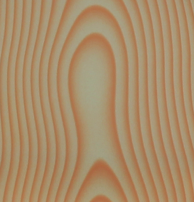
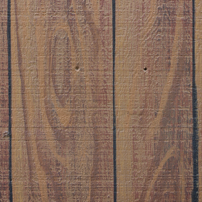
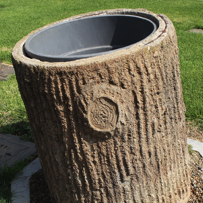
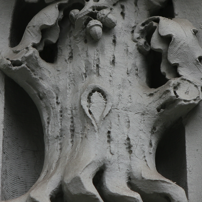
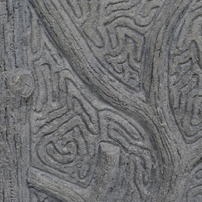
El trabajo rústico cement wood art of San Antonio
Aristotle may have been the first to introduce the theory that “Art imitates nature,” but faux bois (false wood) folk artist Dionicio Rodríguez of San Antonio perfected the skills to convincingly turn theory into reality. Rodríguez’s artistic manipulation of reinforcing steel along with the plasticity of cement is so convincing that one has to look twice to discern that his pieces are in fact not natural. The faux bois master started an art tradition that he had brought with him from Mexico into the Southwest that continues through the third generation of his family today. Click here to view Rodriguez work in Little Rock, Memphis and Suitland, Maryland.
Trolley stop, faux bois (1927), Alamo Heights
Dionicio Rodriguez, San Antonio, Texas
This distinctive art form traces its origins to ancient Egypt where artisans skillfully painted surface decoration to imitate wood grain. Three-dimensional wood imitation using cement is of more recent origin and can be attributed to the invention of ferrocement (ciment armé) first developed in 1867 by gardener Joseph Monier (1823-1906). Because of his dissatisfaction with the fragility of terracotta garden pots, he began experimenting by using iron mesh to create various shapes for garden containers to which he applied cement. In 1875 Monier designed the first iron-reinforced cement bridge ever built at the Castle of Chazelet in France. The bridges design utilized Ferro cement in its decorative motif of wooden limbs and branches so as to blend into the garden. Many other excellent examples are still to be found in French architecture, interiors and gardens. The popularity of the style has made numerous inroads into other countries as well, including the Yildiz Palace gardens in Istanbul and in other locales across the globe.
Detail, waiting bench, trolley stop, Alamo Heights, Texas
The story of San Antonio’s faux bois structures date from the 1920s when Mexican immigrant Dionicio Rodríguez’s (1890-1955) was brought to the city by wealthy Mexican political exile Dr. Aureliano Urrutia who commissioned him to work in the el trabajo rústico, (rustic work) style at Miraflores, his elaborate and palatial house and gardens. Rodríguez had developed his techniques through his training in creating imitation rocks and later by reproducing ruins of ancient buildings in Mexico. The masterful works of Rodríguez are so highly detailed that the delineation of bark, insect holes, tree rings and wood patterns, along with the application of his secret coloring chemicals and stains, produced such convincing and notable works that they became instantly popular. To accomplish this he used simple tools such as forks, spoons, knives and branches when modeling the wet cement and often worked behind a screen or inside a tent to keep others from learning his secrets. Rodríguez’s work from over 30 years took him around the country creating pieces in Tennessee, Arkansas, Maryland, Michigan, New York City and New Mexico. These public and private works include street and garden furniture, bridges, grottoes, trolley and bus stops, benches, palapas, fountains, tree trunks, tree houses, cacti, mushrooms, thatch and much, much more.
Close-up showing faux insect holes and bark,
trolley stop, Alamo Heights
Roman marble sculpture, Diadoumenos
1st-2nd cent. AD, courtesy Metropolitan Museum, NY
Over the years, Rodríguez had many assistants and one, Maximo Cortes, to whom he was related by marriage, eventually practiced the craft on his own later passing his knowledge on to his son Carlos who had assisted him in numerous projects. Today, Maximo’s work can also be seen in and around San Antonio along with that of his son Carlos. For anyone interested in the style, San Antonio is a natural starting point to experience and understand the superb pieces all three have created. Most notable are Rodrígues Trolly Stop in Alamo Heights (1927), The Japanese Tea Garden Gate (1942) at Brackenridge Park along with five other works including the well-known foot bridge (1925), Buckeye Park gate (1926), Quarry Market, the former Alamo Cement Company headquarters fence and palapa (1920s), The façade of the Jacala Restaurant building (1952), Miraflores Park, ten works (1920s), Spanish Governors Palace, benches and light poles (1930) and the Stations of the Cross at the Shrine of St. Anthony of Padua (1936)
FAUX BOIS
Faux Bois cement bathroom wall, at the rear of Notre Dame, Paris
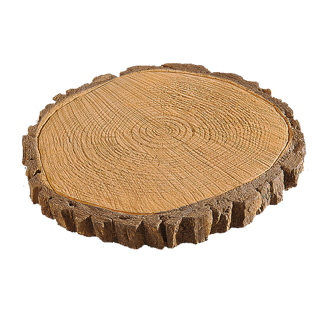
Carlos Cortes is the third generation to continue the family tradition in San Antonio following that of his great-uncle and father. Cortes operates his Taller-Studio on a sun-filled corner lot where he has many of his and his family’s works on display. The affable Cortes is easily engaged in discussing his family’s history, work and techniques to those interested in stopping by.
Carlos’ works can be seen at the Witte Museum HEB Science Tree house (1997), the Lavaca bus shelter (2005), Landa Library, Palapa (2008) and tree stump (2013) and the River Walk extension river grotto, (2009) among others. Carlos also restored the well-known Mary Ann’s Pig Stand (1921) a cement stucco building located across from his studio in 1966.
Faux Bois cement palapa. Taller-Studios, San Antonio, Texas
Curved cement bench and detail. Taller-Studios, San Antonio, Texas
Curved benches and planter. Taller-Studios, San Antonio, Texas
Man with burro and bridge.Taller-Studios, San Antonio, Texas
The Pig Stand, cement (1921) restored by Carlos Cortes in 1966.
San Antonio, Texas
Faux bois cement stepping stone
All across America there are numerous other examples of the faux bois style to be found in cast iron, bronze, cement, glass, plastic resins, carpeting, paint and carved stone. A once popular rendition are the carved stone “tree-stump” tombstones created by the Woodsmen of the World of Omaha, Nebraska and similar life insurance associations in the late 19th and early 20th century. The company, often referenced to by its initials, WOW, started in 1890 by assuring prospective members that “No Woodman shall rest in an unmarked grave.” A unique benefit of membership was the signature tree-stump tombstone placed by the company as a lasting memorial.
Tombstone. Butte, Montana
Crucifix. Natches, Mississippi
Trees. Garden of Eden. Lucas, Kansas
Portrait of Georgia O’Keeffe (1982), wood carving cast in bronze, Marisol.
San Francisco, California
Cast iron branch. Washington, D.C.
Tree stump garbage container. Forest Lawn
Hollywood Hills, Califronia
Glass plywood surround, (2006) Sweden House, Swedish and Icelandic Embassies.
Washington, D.C.
Inflatable corral. Bryant Park
New York City
Still quite popular are cast cement garden furniture and accessories such as wood cross section steppingstones, hollow log and stump plant containers along with tables and benches. These mass-produced decorative pieces however are sadly lacking in the great attention to detail and loving care given to the processes by masterful artisans.
Cast cement outdoor table set.
Townsend, Montana